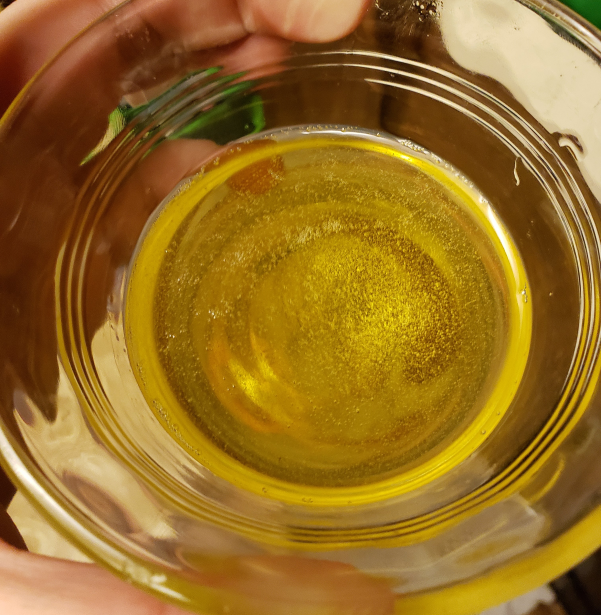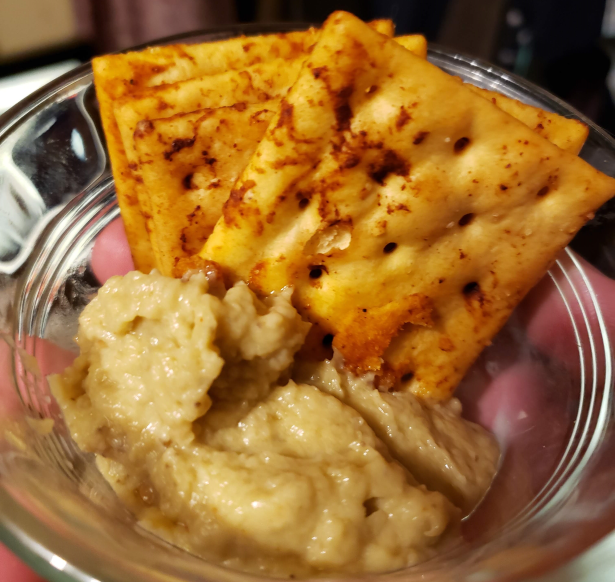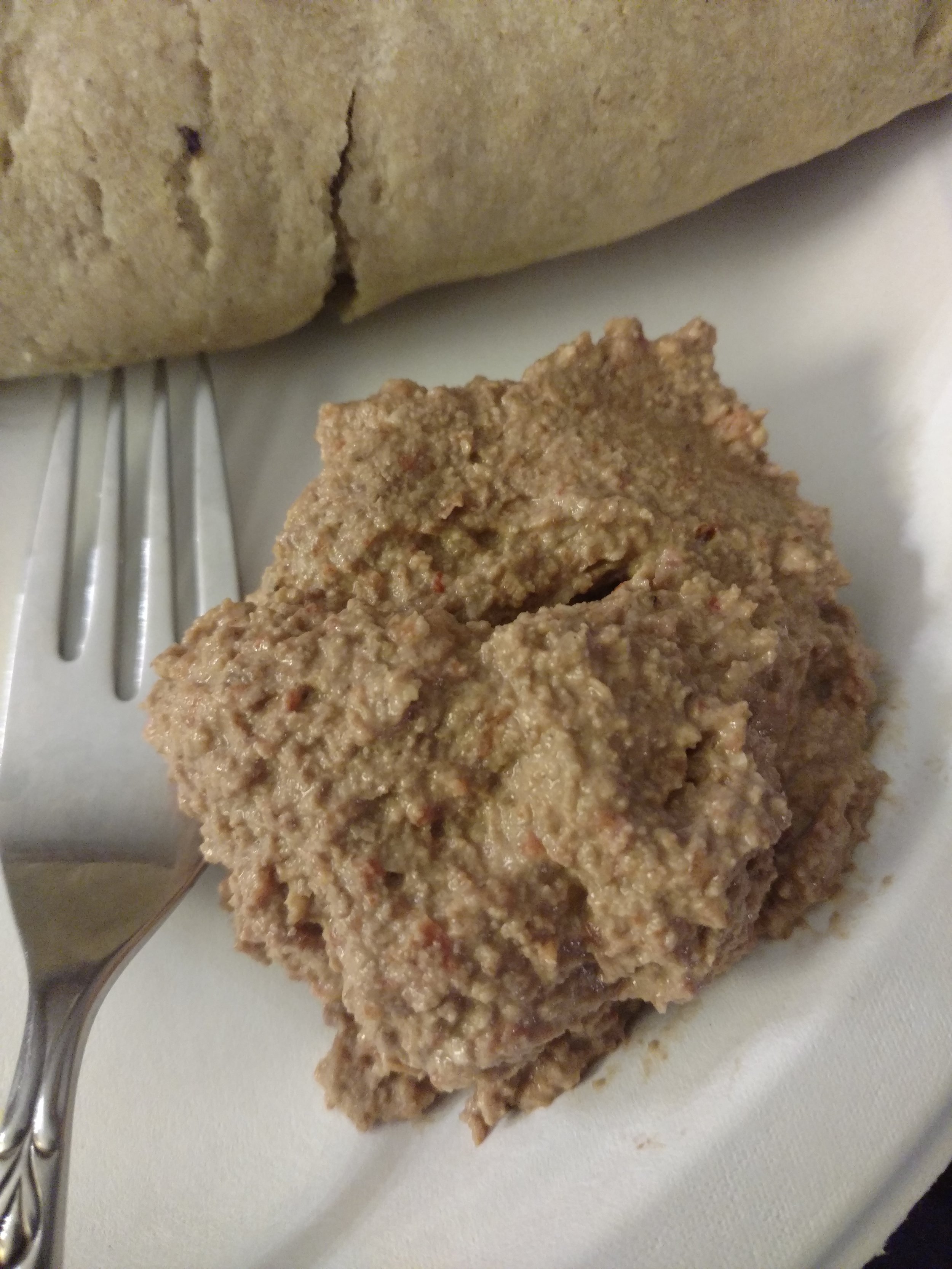KC 224 – Baba Ghanoush and Hot Saltines

Why hello there, and welcome back to a steamy edition of Kitchen Catastrophe. I’m your Carnal Culinaire, Jon O’Guin, and today, we’re doing things the primal way. No fancy tricks, just good old-fashioned fun. I don’t know why I’m talking like this, I had a Vanilla Coke earlier, and I think the caffeine is driving me insane. SO if you’re down to get dirty, read on. But if you want your fun with less foreplay and all action, click this link to go straight to the recipes.
How Incredibly Awkward for All of Us.
DON’T KINKSHAME ME, TITLE JON! I kid, of course. ALL of that was because it’s part of the hilarious history of today’s primary dish: Baba Ghanoush. Ganoush. Ganouj? Oh, good, they’re all somehow correct. DAMN YOU ROMANIZATION.
“You’re going to learn to love Guanciale, motherfucker!”
Specifically, no one’s 100% sure where the name comes from. “Baba” is Arabic for “father”… kind of. Technically, it’s closer to say it’s Arabic for “daddy” or “papa”: it’s not something you would typically call your father in public setting. I don’t THINK it has any of the sexualization that ‘daddy’ has adopted in modern English. (As a great linguistic exercise, a disturbingly effective example of differences in connotation is the fact that, from the raw definitions of the words, there’s not much difference between “Forgive me, father, for I have sinned”, and “I’m sorry, daddy, I’ve been a bad girl.”) However, this might actually suggest an attempt to do something like that. See, people can’t decide if ġannūj (the original word) was a NAME, or if it was a bastardization of another word based on a word that’s been translated as “coquette”, “flirtatious”, “pampered/spoiled”. The dish might be named “Flirty Daddy”, or “Big Spoiled Papa”, which is definitely not something I would recommend calling it when offering to friends, family, strangers, or really anyone you believe speaks English. “Would you like to taste my Big Spoiler Papa?” is a question that haunts the mind like other searing crimes against humanity. The only thing that makes it worse is the implication that it was likely invented in a harem setting for a sheikh or sultan, and therefore could be applied to Jasmine’s dad from Aladdin.
“Ooh, I love it when they call me Big Papa!”
Anyway, now that we’re all traumatized forever, the dish is actually…well, there’s something of an issue regarding what exactly it is: basically, there’s two dishes that are relatively similar: mutabbal and baba ghanoush, and which is which and what marks the difference is moderately confusing. I’m calling what I made Baba ghanoush, because that’s what the recipe I’m copying called it. This is a dish of blended eggplant*, tahini**, lemon juice or sumac, and olive oil. Some claim that THIS is technically mutabbal, and baba ghanoush is when you make a larger salad using this dip, pomegranate, nuts, etc. Others say the difference is whether you use Tahini, its’ all a jumble.
* - If you’re still internally screaming about the idea of Jasmine’s plump father, shirtless, his ball-like torso lightly covered in curly gray hair and eating dip, it may slightly abate your suffering to know that at least one group suggests that the EGGPLANT maybe the reason for the name: The eggplant is considered by some cultures (primarily India) as “the King of Vegetables”, and so some suggest IT is the “baba” referred to in the dip’s name. Sort of like if an American made a Christmas Pork Roast dish, and called it “the OTHER White Christmas” after “the OTHER white meat” ads, or a baked apple dessert called “the Doctor Destroyer”, since an apple a day keeps the doctor away!
**- There’s a VAGUE possibility that maybe the Tahini has something to do with it, but that’s probably just me sucking at transcribing Indo-Irani languages. All I know is I looked up the word “coquette” in Arabic, found the one that SOUNDED most like “ghanoush” (Which had a similar sounding end and beginning, with a change in the middle, like “gha-NA-nouj”), and then struggled to get it Romanized, (I had the Arabic characters, but wanted them in “English” letters.) My effort vomited out “tehenj” as a VERY rough attempt at the spelling, which is apparently a word/name in one of the INDIAN languages. And for some reason Google was instantly like “are you sure you didn’t mean tahini?” which is weird, because TAhenj doesn’t trigger that, because it instead said “Oh, you want Tahaj, a dialect word for “Tahj”…which is Persian for “Crown”…Look, I went down a rabbit hole here.
Pretty big rabbit hole. Maybe a well.
And that’s probably because this is actually a super simple recipe. I got my version from Kenji Lopez Alt, and screwed it up, so…you know, learn from my mistakes I guess.
If you’ve never had it before, don’t worry, neither have I. Apparently, its’ supposed to be smoky, creamy, a little acidic/bright, and savory. Mine…well, we’ll get to it.
The first step it to char some eggplants. This is where you get the smoky flavor from. And while my eggplant was almost the platonic ideal of an eggplant:
One chunky boi.
It was NOT entirely ideal for this recipe. Why? Because Globe eggplants are too big. Smaller Italian eggplants would be better. And failing to account for that is really the core of my screw-up. See, the recipe calls for cooking the Italian eggplants for 30-40 minutes, until heavily charred, and completely limp. Kenji says you should literally go “until you think they’re burnt beyond saving”. Which, since this was my first time working with the vegetable, I was a little jumpy on.
Looking back, it’s clear I just forgot to do the math: in my head, I was doing a smaller recipe (My batch is about half what Kenji’s recipe makes), so I could use the reduced amount of eggplant to compensate for the increased size. Which would be FINE if I did the math right: the original 2 pounds was made up of 3 eggplants. Mathematically, that means that each of those eggplants is supposed to be roughly 2/3s the size of mine, and therefore I should cook mine for 3/2s as long, so instead of 30-40 minutes, I should have done 45-60 minutes. I pulled mine…probably right around minute 45. My phone tells me I took that picture from earlier at 6:10. At 6:46, the eggplant looked like THIS:
I was going to make a joke about this being a “char boi”, and relate it to a song…but I’ve completely forgotten which one. It wasn’t Starboy…the next line was something about “dun dun the right way to grill”? It’s very frustrating.
And I had it inside in foil wrap 2 minutes later. So I probably should have let it sit on the grill another 5-10 minutes to really get some char flavor. Because, spoilers, that’s basically the major ‘problem’ with my finished product: it’s just not very smoky, (at least, not by my standards. To me, it’s not smoky unless thick enough to choke an infant, an undressed bear talking about fires, or looks like the eye of someone ruling on the Nile. That’s right, a smoky eye reference, AND a Smoky the Bear reference.) which kind of throws the whole thing to a weird place. Let me explain.
Really quickly, the big part of this process is handling the eggplant: you grill it or broil it for 30+ minutes, then you gotta let it steam itself for 10 minutes, THEN you have to ‘clean’ the eggplant (just spoon out the meat from the burned skins, the steaming should have made it pretty easy, and try and scoop out any chunks you see RIDDLED with seeds, since they can be firm and bitter ). THEN you’ve got to drain it, which Kenji discovered is actually pretty easy to do quickly if you’ve got a salad spinner: just spin the crap out of it for 30 seconds, and BOOM, drained eggplant. (if you DON’T have a salad spinner handy, you can just let the eggplant sit and drain in a fine mesh strainer for like, an hour)
SPIN IT!
From there, you’re basically making a hand-whipped hummus or mayonnaise: you want some minced garlic, some tahini, some lemon juice, and the eggplant, and you want to just whisk the crap out of it with a fork to beat everything into a smooth paste. THEN, you want to slowly drizzle in olive oil while whipping, to emulsify everything. What does that mean? Well, the water in the lemon juice and eggplant don’t WANT to hang out with the oil in the…oil. So if you just tried to stir them together gently, you’d just end up with puddles. By fiercely whisking them together, you beat them into a sort of gelled matrix. Once you mix it all together, you’re supposed to add chopped parsley, but A: I didn’t want to, and B: I thought it would make it a harder to get Nate/my mother to try it.
Now, since I had tasted it, and there wasn’t much smokiness, I added some smoked paprika in the hopes that it would punch things up. While it helped a little, it didn’t close the deal.
Kind of looks like a banana paste.
The AMAZING thing, however, is the condition of this failure: This is a perfectly fine dip. It’s almost like a slightly sweet hummus, with a little looser texture (Like, you know how hummus has an almost peanut-buttery stickiness? This is more like softened butter.) Like, if someone presented this to me at a picnic, I would assume it was something I didn’t understand, made correctly. Not a screwed up version of something. It’s also SUPER cheap and fairly easy (I mean, really, think about it. The directions I had were “cook a single vegetable for a while, let it sit for a while longer, beat it with other stuff.”) AND it’s vegan, so it’s a great recipe to have in my back pocket.
On the other hand, Before I went into that rabbit hole earlier, I assumed I was going to be super-pressed to fill the post with anything interesting to say. (One downside to how I’ve been operating of late is I’ve been jumping at a lot of faster recipes based on technique, rather than an interesting narrative hook.) As such, I figured “why not crank out another simple recipe to go WITH the dip? And hey, if the dip’s not smoky enough, let’s fix that with this thing!”
We’re Talking Hot Stuff Baby This Evening
This is a recipe for “Hot Saltines” by Alton Brown. It is, at its fundamental level, basically a recipe for “Buffalo Crackers’. What is THAT supposed to mean? Good question. Let’s unpack it.
“You gonna pack WHAT, after calling me a cracker, Jon?”
You know “Buffalo wings”? Classic American bar food, named for their invention in Buffalo New York, at the Anchor Bar? One of the least upsetting examples of a food history out there: Italian family runs a bar in Buffalo, kid comes to the bar one night with some friends, they’re hungry, mom makes them a snack. Only thing is everything by the fryer’s off, and the kids wants something spicy. She melts some butter, mixes it with hot sauce, tosses some fried chicken wings in the mix, serves it up. Bing Bang boom. That’s it.
That’s also the core of a buffalo sauce, by the way: fat (originally butter, but sometimes oil) and hot sauce. So, obviously, this recipe is just slather some Saltines in buffalo sauce, bake them dry, and boom. Recipe done. Except there’s a problem there. Two problems, actually: water, and milk solids. Butter is, physically, something like 80% water and 20% milkfat. Thus, if you toss these saltines in melted butter, they’re going to soak up that water, and need time to dry. But, in the time (and heat) it takes to dry out the saltines, the milk soilds are going to darken up. (milk solids being the things that brown when you make brown butter: little flecks of milk protein) So you need to reduce the amount of time you need to bake the crackers. And that’s where you need some clarity. Or rather, Clarified. Butter.
Ghee Whiz! (That’s not how you pronounce Ghee. It’s “gee”.)
Clarified Butter is butter that’s been simmered over time to remove all the water, leaving ONLY milkfat. It’s also the little tub of hot butter you get with lobster or crab in good places. You may note that jar says that it is Ghee. That technically means it’s NOT clarified butter, since Ghee is clarified butter that was cooked even longer, and a little hotter, getting a little bit of that milk solid browning. IF that sounds confusing, think of it this way: Clarified butter is a slice of bread. Ghee is a slice of toast, made from that same bread.
It stores for a long time as long as you close the jar when you use it, and keep water from getting on it. I have a jar of ghee because it’s a very popular and critical ingredient in a lot of Indian cooking, which I’ve been meaning to try. Anywho, melt your ghee with a quick stint in the microwave.
Melted butter always looks cool.
Then, get some dry mustard, and hot sauce. Now, Alton doesn’t discuss his preferred hot sauce in the cookbook, but I figured, being a good Georgia boy, we were meant to infer something Tabasco-esque: somewhat spicy and vinegary. Which I used for about half of the hot sauce mix. The OTHER half was Mezclajete, a hot sauce we bought from a local Italian restaurant of all places. I say “of all places” because it is a VERY Mexican style hot-sauce: the name is a portmanteau in Spanish (of Mezcla, “mix/mixed” and probably Molcajete, a sort of volcanic stone Mortar and Pestle native to Mexico) and it’s based on Chipotle and Guajillo chiles. So it’s a smoky but not super spicy sauce, hence why I thought it might be good for this mission. The one thing I worried about was maybe the little flecks of pepper in the sauce could burn in the bake, but I thought that unlikely.
Time to PEP things up!
Mix together the sauce components, and toss in a sleeve of saltines, lay out on a baking sheet, and cook for 8-10 minutes, until they’re starting to brown slightly, and look dry.
The results were…honestly, I almost felt like “more of the same”: These don’t have a huge taste of spiciness, they just taste like a slightly overcooked saltine, with a slow burn the kind of taps you in the throat a little bit after you eat it. IT’s nice, not amazing, and it worked fine with the baba ghanoush.
And they look good together too.
That’s two relative successes, where I wasn’t really disappointed with my results, but I wasn’t impressed by them. But hey, that’s how it goes sometimes.
THURSDAY: ASSUMING I’M NOT BETRAYED, WE’LL BE COVERING A SHOW!
MONDAY: MAYBE NOODLES, OR MAYBE SOMETHING ELSE.
Welcome, you sexy things, to the
Recipes
Baba Ghanoush
(This is Kenji’s recipe, mine was half this. And omitted the parsley)
Serves 4-6
Ingredients
3 medium Italian eggplants (about 2 pounds/900g total)
3 medium cloves garlic, minced
2 tablespoons (30ml) juice from 1 lemon, plus more as desired
3 tablespoons (45ml) tahini
1/3 cup (80ml) extra-virgin olive oil, plus more for serving
1/4 cup chopped fresh parsley leaves
Kosher salt
Preparation
In a gas or charcoal grill, bring to medium heat and place eggplants directly over heat source. Cook, turning occasionally with tongs, until eggplants are completely tender and well charred on all sides, 30 to 40 minutes. Wrap with foil and let rest 15 minutes. OR, if broiling in the oven, adjust rack to 6 inches below broiler element and preheat broiler to high. Place eggplants on a foil-lined rimmed baking sheet. Broil, turning occasionally, until charred on all sides and completely tender, about 1 hour. Eggplants should be very, very tender when cooked. Test near the stem and bottom ends; if a toothpick or skewer meets any resistance, continue cooking. Remove from oven and gather up foil, crimping it around the eggplants to form a sealed package. Let the eggplants rest for 15 minutes.
Open foil package. Working with one eggplant at a time, use a sharp paring knife to slit each eggplant open lengthwise. Carefully scoop out soft flesh with a large spoon and transfer to a strainer set in a large bowl. Once all eggplant is scooped, pick out any stray bits of skin and blackened flesh and discard.
Transfer eggplant to a salad spinner, distributing it evenly around the perimeter. Spin gently until all excess moisture is extracted. Discard all drippings, wipe out large bowl, and return eggplant to bowl.
Add garlic and lemon juice to eggplant and stir vigorously with a fork until eggplant breaks down into a rough paste, about 1 1/2 minutes. Stirring constantly and vigorously, add tahini, followed by the olive oil in a thin, steady stream. The mixture should become pale and creamy. Stir in parsley and season to taste with salt, plus more lemon juice if desired.
Transfer to a serving bowl, drizzle with olive oil, and serve with warm pita bread or vegetables for dipping. Baba ganoush can be stored in an airtight container in the refrigerator for up to 4 days. Let baba ganoush warm to room temperature before serving.
Hot Saltines
Makes roughly 40 crackers
Ingredients
2 tablespoons clarified butter or ghee, melted
1 tablespoon hot sauce
1 teaspoon dry mustard
1 sleeve Saltines (roughly 40 crackers)
Preparation
Preheat your oven to 350 degrees.
In a large bowl, mix together the butter, sauce, and mustard. Toss the saltines in the sauce.
Spread saltines on a single layer on a baking sheet. Bake for 8-10 minutes. Let cool and serve.

















